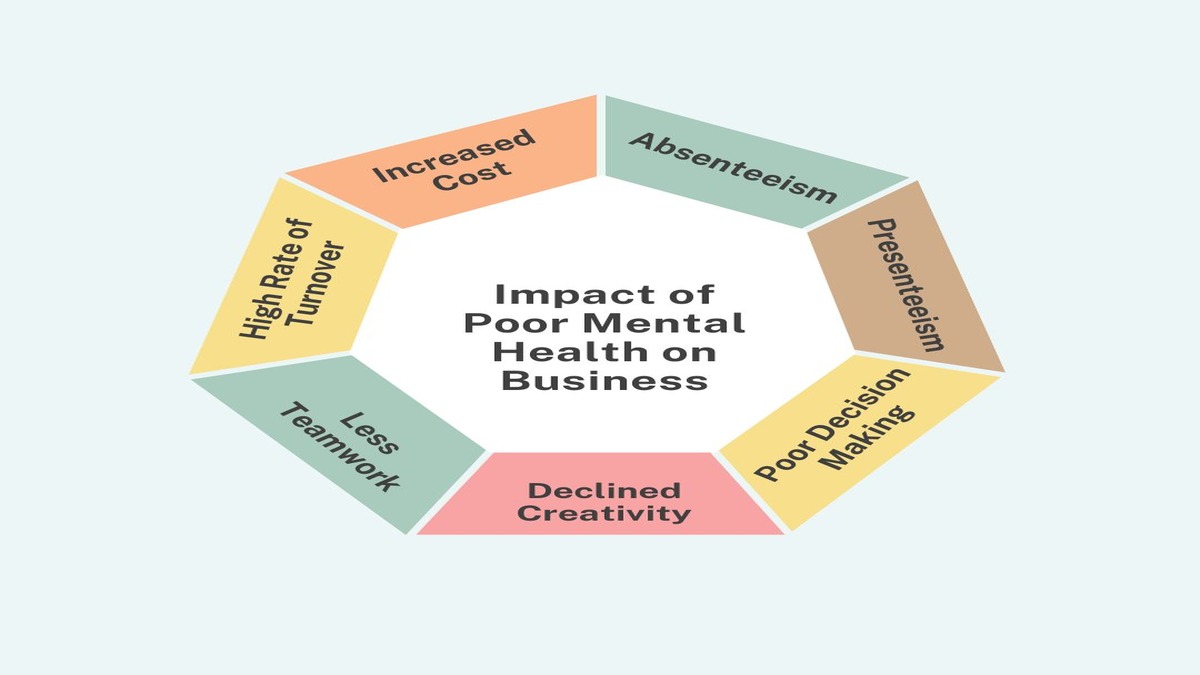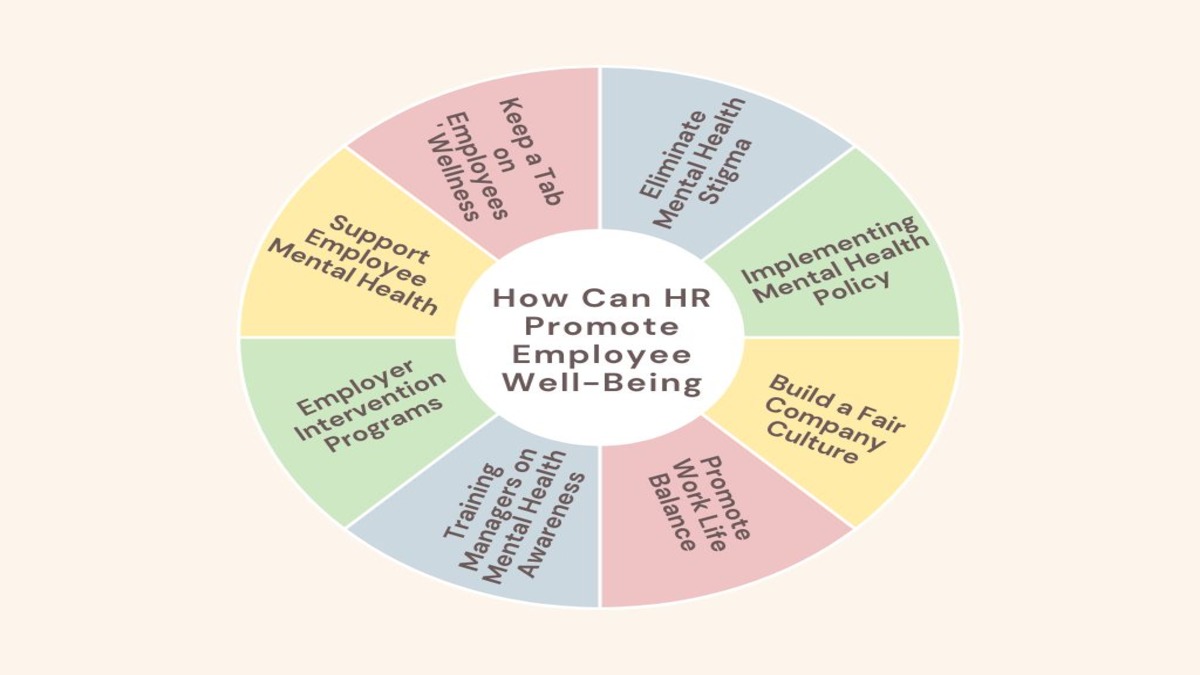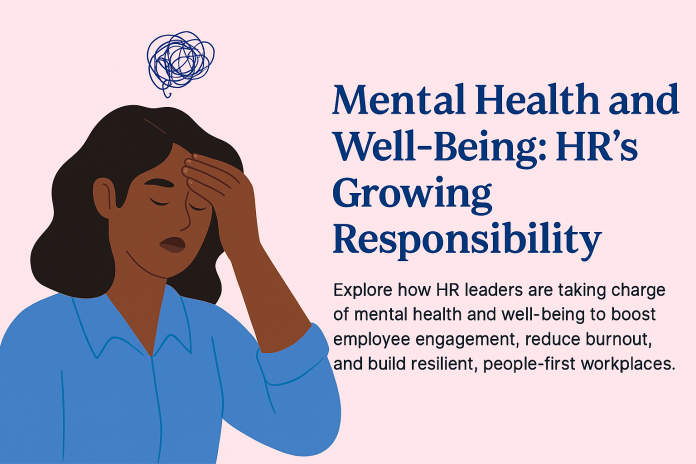An individual spends approximately a fifth of their lifetime at the workplace. Regular employment is a source of psychological assurance and social safety, but it becomes acutely ironic if we consider the increasing anomalies of mental illness within the working population. Addressing mental health problems and ensuring employee well-being in the workplace are some realistic expectations from an employer. The success of an organization largely depends on its intent to create a work environment that promotes employee wellness and facilitates a people-first culture. This article examines the interrelation between work and mental health, the adverse effects of poor mental health, and explores how HR can look out for their employees’ emotional well-being.
What is Mental Health and Well-being in the Workplace
Understanding mental health and well-being is the starting point in building a thriving work culture. According to the World Health Organization, mental health is a condition of complete psychological, emotional, and social well-being, and not just an absence of illness. At the workplace, it is seen as an individual’s capability to contribute productivity without a sign of distress. A mentally balanced employee can focus, make sound decisions, and think critically.
Emotional well-being is a part of mental health that lets us regulate our emotions so that we may cope with the stress around us. The better the state of emotional well-being, the better the response to stressors and challenges. Employees with a high level of well-being are happy, resilient, and highly engaged. Nurturing emotional well-being is as important as promoting mental health to achieve holistic wellness and overall organizational success.
Prevailing Work-Related Mental Health Challenges
Global figures concerning mental health issues at work have compelled employers to rethink their staff policies and include initiatives supporting employees’ mental well-being. As per an estimate by the WHO in 2022, approximately 60% of the world’s population is working, with 15% suffering from mental health ailments with varying severities. In 2019, almost 301 million and 280 million people experienced anxiety and depression, respectively. These disorders together resulted in 12 billion unproductive workdays costing the world economy about US$1 trillion.
According to a 2020 report published by the Global Burden of Disease Study, around 14% of the population in India is living with mental health conditions, implying that the majority are from the working age between 15-59. Another survey by Great Place To Work, India, 2023, indicates that 16% of employees in the top 25% workplaces are affected by high burnout, while a troubling 40% of employees in the bottom 25% are experiencing high levels of burnout.
Significant data collected over the past years recorded a surge in the figures of mental health conditions during and after the COVID-19 pandemic, which can be attributed to grim work conditions and financial pressures. Consequently, the topic of mental health and well-being, which was once considered a stigma and often discussed inside closed conference rooms, has moved mainstream with a greater number of organizations being open to conversations and resolutions favouring the workforce.
Impact of Poor Mental Health on Business

Mental health not only affects an individual’s daily life but also has a far-reaching impact on their work performance, which can be detrimental to business sustainability and its growth. If revenues are falling, profitability is declining, deliverables are slow, and quality is inconsistent, there is a high probability that employees are distracted and their well-being has taken a toll. Low levels of mental health and well-being among the workforce can manifest in several ways that includes:
Absenteeism: Depressed workers have a higher tendency to call in sick or take unexplained leaves that directly disrupts routine business operations by creating scarce manpower and increasing workload.
Presenteeism: It is a situation where an employee is physically at work but mentally distant. This behaviour can be more harmful than absenteeism, as an absent employee may not contribute for a certain time, but a presentee with low mental well-being may work regularly yet deliver poor outcomes. Presenteeism harms businesses slowly, and its effects can be long-term.
Poor Decision Making: Employees dealing with prolonged stress and burnout lose their ability to concentrate and process information rationally, leading to recurrent mistakes and poor judgment, which ultimately impacts business performance.
Declined Creativity: Innovation takes a backseat when employees show little enthusiasm for creative work processes. Introduction of new methods or changes in systems is a product of a positive imagination, and a healthy workforce is perhaps more inclined towards change and transformation.
Less Teamwork: Employees dealing with psychological distress gradually withdraw from team interactions, which widens communication gaps, creating confusion and mistrust in the workplace. Poor interpersonal relationships pervade across the hierarchical structure, eventually messing up team dynamics.
High Rate of Turnover: Longer periods of burnout result in employees leaving the organization, causing a manpower crisis. Shortage of personnel not only increases the number of duties performed by one employee but also leads to dissatisfaction and resentment among existing employees, creating an unending loop of mental breakdown.
Increased Cost: A poor state of employee well-being can weigh heavily on employers in terms of added costs. Lost manhours due to irregular attendance, high rate of turnover, replacement, and training expenses are additional overheads that a company can be forced to bear if employee mental health remains unchecked.
Indications of Mental Health Struggles Among Employees
Employees suffering from mental health problems can show different signs and symptoms. Recognizing these behaviours early can alleviate further exacerbation by ensuring timely intervention. If the following are noticeable among the workers, they may be at risk of a mental illness:
- Sudden mood swings, including irritability
- Panic episodes
- Social withdrawal
- Intense outburst of anger
- Ignoring personal hygiene or grooming etiquette
- Chronic headache or fatigue
- Memory loss or poor cognitive functioning
Workplace Triggers Affecting Mental Health
According to a published study by Spill, at least 1 in 6 people are facing mental health issues in the workplace. The factors that cause stress at work are known as psychological risks or psychological hazards. Employees are exposed to certain circumstances in their work establishments that make them vulnerable to mental health disorders. A poor working environment directly contributes to stress, anxiety, or burnout, deteriorating mental health.
Psychological risks can be related to work systems, social influence, or workers’ career expectations. An unorganized management structure undermines leadership, giving rise to ambiguous reporting lines, unclear job roles, overlapping responsibilities, and unrealistic work demands, creating mental strain among employees. Excessive workload, unpredictable working hours, periods of inactivity, micromanagement, and lack of participation in decision-making are also system flaws that add to the accumulating stress and anxiety.
Some employees also face discrimination at work due to social, cultural, or demographic factors, such as age, gender, education, religion, region, or nationality. Unhygienic work conditions, pay disparity, favouritism, bullying, harassment, lobbying, or power struggles are a few examples that stem from discriminatory practices in the workplace.
Psychological hazards are further compounded when career goals of employees are not met or contradicted in the present environment. Discouraging appraisal policies, inadequate training, and limited room for career development add to the frustration and reduce the morale of employees. Over time, this leads to job dissatisfaction, mistrust in leadership, and a higher likelihood of turnover.
It is important to note that there are no core explanations that upset the mental balance of an employee. There can be just one or as many reasons that may affect them, and it is crucial that employers are aware of these stressors to foster a progressive work culture that takes cognizance of employees’ emotional well-being.
How Can HR Promote Employee Well-Being

Employees have the right to a work environment that boosts their morale, making work an enjoyable sport. HR plays an important role in addressing mental health in the workplace. While it may not be possible for them to prevent employees from experiencing troubles due to their personal choices or situations that may develop outside work, they have a greater responsibility in assuring employees of a positive experience while they work. They can lead this charge by educating themselves about mental health conditions, paving the way for implementing strategies to uplift employee well-being. Here are some HR interventions to support employees’ mental health and emotional well-being.
Eliminate Mental Health Stigma
Mental health has long been subjected to taboo in society, including the workplace. Such topics can be sensitive, but looking down upon them or even ignoring them can become an obstacle in countering such conditions. A stigmatizing attitude draws negative behaviors from coworkers and dissuades employees from seeking help. Public stigma limits growth opportunities, preventing affected employees from faster recovery and returning to work.
The first step to reducing stigma is your commitment to protecting and promoting mental health and employee well-being and ensuring a work environment free from psychological stressors. By building an open culture that supports interactions and activities supporting mental wellness, you can instill trust among your workforce. To make this happen, demonstrate your willingness towards the cause. Provide assistance, resources, and ensure implementation of programs that advocate the right to a safe and healthy working atmosphere.
Implementing Effective Mental Health Policies and Programs
Supporting the mental health of your employees should go beyond simply taking note of psychological issues. Document policies that enforce and monitor initiatives to foster a healthy work climate. Make sure that the policies aim to curb the prevalence of stigma through consistent awareness, addressing common mental health challenges, and sharing details on how to deal with them. The policies must include information about all the support systems, resources, tools, or financial aid available when workers reach out for help. For policies to be effective, they should be communicated clearly and made accessible to all staff members. Further, it must be flexible to incorporate newer practices and be reviewed regularly.
Streamline Jobs and Build a Fair Company Culture
A workplace built on transparency and respect thrives because employees feel valued and psychologically safe. Promote equal opportunities and prioritize respect and diversity. Policies addressing discrimination and derogatory behaviour should be implemented, allowing affected employees to safely report occurrences. Lay down defined roles, reporting structures, and standard appraisal guidelines to avoid confusion. Analyze jobs periodically to help workers reach their optimal potential. Engaging your employee in the process of job design and decision-making impacting their work process will make them feel valued. Organizing your work structure reduces conflicts, improves engagement, and increases positive mental health.
Promote Work Life Balance
A healthy balance between personal and professional life prevents exhaustion and reduces stress. Allow employees to choose working hours as per their convenience. Increase the number of shifts to help them match their requirements. Restrict atypical working hours and discourage habitual overtime. Set realistic targets and provide employees with the right resources to meet their deadlines. Allocate paid time off to employees to destress themselves and allow for breaks or leaves reasonably if they approach with requests. Including the option for remote or hybrid work for specific circumstances, like child or geriatric care, can put workers at ease and lessen their overall burden.
Training Managers on Mental Health Awareness
It is possible to have a stress-free work environment and a supportive work culture if leaders are resolutely involved in this process. Training your team leaders and supervisors is crucial for the success of mental health programs and initiatives. Managers are the face of the organization as they directly influence the behavior and attitude of their team. Sensitizing them about mental health and psychological risks can enable them to recognize the early signs, so they can guide the employees to avail appropriate support systems and resources. The training program should be imparted by expert trainers and include topics on identifying the symptoms, effective communication strategies, crisis intervention, and fostering a culture of inclusivity and psychological safety.
Provide Employer Intervention Mental Health Programs
There are diverse ways to assist employees experiencing stress, burnout, or anxiety at work. Conduct workshops to spread awareness about mental health among employees. This can reduce general stigma and hesitation and create an atmosphere where workers can be more confident to share their feelings. The training can also help workers reduce self-stigma and encourage them to seek help when needed.
Organize an internal mental health-friendly group with whom employees can have a confidential space to discuss their mental health concerns. The group will be responsible for providing access to suitable resources such as stress management techniques, wellness applications, mental health toolkit, and connecting them with external counseling services or professional therapists. You can also station a recreation room within your premises where employees can rest, play games, socialize, or read self-help books. A quiet zone will allow them to take a productive break from work and refresh themselves.
Assist Employees With Mental Health Conditions at Work
One of the essential duties of HR is to support employees having disturbing signs and symptoms. While being considerate, it is important to remain cheerful around them, normalizing the condition and making them feel accepted. Sanction and extend breaks so they may fully recover, and check in with them when they are off duty. Welcome them with greetings when they return to work and help them pick up from where they left off. If necessary, make adjustments in their job design and work schedule, helping them adapt to work gradually.
Keep a Tab on Employees’ Wellness
Measure the effectiveness of your mental health initiatives frequently to truly understand if they are benefiting your employees. Review the wellness index with clear metrics and periodic evaluations. Surveys and anonymous feedback can give good indications of employee satisfaction, stress levels, and overall psychological well-being. Tracking key indicators like absenteeism, turnover, and productivity can reveal vital patterns linked with mental well-being. Moreover, the participation rate in training sessions and counseling services is an important determinant of engagement and accessibility. By consistent analysis, you can see what’s working, plug the gaps, and plan initiatives to meet the expectations of your workers.
End Note
A happy employee is a productive employee. Motivated employees are engaged and have higher levels of job satisfaction. Mental health is a growing priority as employees face increasing pressures, from tight deadlines to balancing modern work-life demands. It is common to have stressful situations in the workplace; however, aiding your workers with proactive coping strategies can work wonders in ensuring their well-being. Investing in the mental wellness of employees is not just a moral obligation but a key driver of business performance. Implementing policies and programs supporting mental health and integrating them as a part of your core principles lets you cultivate a healthy, inclusive, and high-performing work culture.
FAQs
1: Why is mental health an important responsibility for HR?
HR plays a crucial role in shaping workplace culture and employee experience. Promoting mental health ensures higher productivity, lower absenteeism, and stronger team morale. When HR prioritizes employee well-being, it reduces burnout and fosters a healthy, engaged workforce.
2: How can HR identify early signs of poor mental health among employees?
HR can recognize signs such as sudden changes in behavior, frequent absenteeism, poor performance, withdrawal from colleagues, or visible fatigue. Regular check-ins, open communication, and wellness surveys can help identify these issues early and ensure timely support.
3: What are some effective mental health initiatives HR can implement?
HR can introduce initiatives like Employee Assistance Programs (EAPs), mental health awareness workshops, flexible work policies, stress management sessions, and access to counseling services. Creating open discussions around mental wellness also helps reduce stigma.
4: How can HR reduce mental health stigma in the workplace?
HR can normalize conversations about mental health by organizing awareness campaigns, leadership endorsements, and employee stories. Training managers to respond empathetically and promoting confidentiality also encourages employees to seek help without fear.
5: What role does company culture play in employee mental well-being?
A fair, transparent, and inclusive culture helps employees feel respected and safe. When organizations encourage work-life balance, celebrate diversity, and ensure equal opportunities, it strengthens employees’ sense of belonging and emotional well-being.
6: How can HR promote work-life balance to support mental health?
HR can promote work-life balance by setting realistic work expectations, offering flexible schedules or remote options, ensuring adequate time off, and discouraging overtime. Supporting personal needs reduces stress and improves job satisfaction.
7: How does poor mental health impact business performance?
Poor mental health can lead to absenteeism, presenteeism, low creativity, poor decision-making, and high turnover. This not only affects productivity but also increases costs related to recruitment, training, and lost working hours.
8: How can HR measure the success of mental wellness programs?
HR can track engagement in wellness programs, analyze absenteeism and turnover trends, and collect anonymous employee feedback. Periodic mental health assessments and satisfaction surveys can show whether initiatives are effective.
9: What should HR do when an employee shows signs of burnout or distress?
HR should approach the employee with empathy and confidentiality, encourage open dialogue, and guide them toward professional help or internal support programs. Adjusting workloads or offering temporary flexibility can aid recovery.
10: How can leaders and managers contribute to employee well-being?
Leaders can create a psychologically safe environment by showing empathy, supporting flexible work arrangements, recognizing achievements, and encouraging self-care. Managerial awareness training can help them spot early signs of mental strain among their teams.
Read More: HR Tech Trends: What to Expect in the Future of Work

